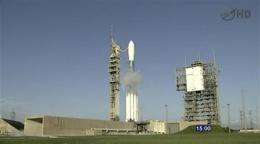Wind delays NASA launch of twin moon spacecraft (Update)

(AP) -- High wind forced NASA on Thursday to delay the launch of twin spacecraft destined for the moon, the first mission dedicated to measuring lunar gravity.
NASA will try again Friday, despite another poor weather forecast: 60 percent no-go. Launch time is 8:33 a.m. The space agency has just two single-second launch windows every day.
Thursday's countdown made it all the way down to the four-minute mark, but was halted because of gusty wind high up in the flight path.
The mission is the first in more than 50 years of lunar exploration that's dedicated to measuring the moon's uneven gravity - about one-sixth Earth's pull. None of the world's previous 100-plus moonshots - dating back to 1959, including the six Apollo landings from 1969 through 1972 - focused on probing what lies beneath the lunar surface.
The twin spacecraft named Grail-A and Grail-B will go into orbit around the moon and chase one another. By measuring the varying gap between the two satellites, scientists will be able to create a precise map of the moon's gravitational field. That will shed light on the composition of the moon's interior, as well as the moon's evolution over the past 4 billion years.
Each of the washing machine-sized spacecraft also holds four cameras that are part of an educational program led by Sally Ride, the first American woman in space. Middle school students around the world will be able to choose lunar targets for picture-taking.
The Grail mission - short for Gravity Recovery and Interior Laboratory - costs $496 million.
NASA anticipated more than 6,000 guests for Thursday's launch attempt, a big turnout for a school day. Grail is only the second mission from Cape Canaveral since the space shuttles retired in July. The Jupiter-bound Juno spacecraft was launched in August and drew a huge crowd - an estimated 12,000 guests - to Kennedy Space Center.
Unmanned rockets are the only game in town for Cape Canaveral until private companies are able to launch their own vehicles with astronauts. That won't happen for at least three to five years.
NASA is relying on Russia to launch American astronauts to the International Space Station in the interim. Russian Soyuz rockets are grounded, however, in the wake of a launch accident two weeks ago involving an unmanned supply ship.
©2011 The Associated Press. All rights reserved. This material may not be published, broadcast, rewritten or redistributed.


















